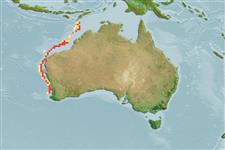Elasmobranchii (sharks and rays) >
Rajiformes (Skates and rays) >
Rajidae (Skates)
Etymology: leptoura: Name from Greek 'leptos' meaning fine, thin or delicate and 'oura' for tail, refers to its somewhat filamentous tail.
More on authors: Last & Gledhill.
Environment: milieu / climate zone / depth range / distribution range
Ecology
Marine; benthopelagic; depth range 202 - 735 m (Ref. 75645). Tropical; 11°S - 33°S, 111°E - 124°E (Ref. 114953)
Eastern Indian Ocean: off western Australia (Ref. 114953).
Size / Weight / Age
Maturity: Lm ? range ? - ? cm
Max length : 48.6 cm TL male/unsexed; (Ref. 75645); 55.5 cm TL (female)
Inhabits upper continental slope (Ref. 114953). Length of adolescent males 32.7-46.3 cm TL, some individuals with no clasper development at 35.6 cm TL; males mature at 39.4-48.6 cm TL, with smallest juvenile at 14.7 cm TL (Ref. 75645).
Life cycle and mating behavior
Maturity | Reproduction | Spawning | Eggs | Fecundity | Larvae
Last, P.R. and D.C. Gledhill, 2008. Two new skates of the genus Okamejei (Rajoidei: Rajiidae) from south-east Indian Ocean. In Last. P.R., W.T. White, J.J. Pogonoski and D.C. Gledhill (eds) : Descriptions of new Australian skates (Batoidea: Rajoidei) pg. 119-134. CSIRO marine and atmospheric research paper no. 021. (Ref. 75645)
IUCN Red List Status (Ref. 130435: Version 2024-2)
Threat to humans
Harmless
Human uses
Tools
Special reports
Download XML
Internet sources
Estimates based on models
Preferred temperature (Ref.
123201): 8.8 - 13, mean 11.3 °C (based on 59 cells).
Phylogenetic diversity index (Ref.
82804): PD
50 = 0.5001 [Uniqueness, from 0.5 = low to 2.0 = high].
Bayesian length-weight: a=0.00302 (0.00141 - 0.00645), b=3.24 (3.07 - 3.41), in cm total length, based on LWR estimates for this (Sub)family-body shape (Ref.
93245).
Trophic level (Ref.
69278): 4.1 ±0.6 se; based on size and trophs of closest relatives
Resilience (Ref.
120179): Low, minimum population doubling time 4.5 - 14 years (Preliminary low fecundity).
Fishing Vulnerability (Ref.
59153): Moderate vulnerability (42 of 100).
